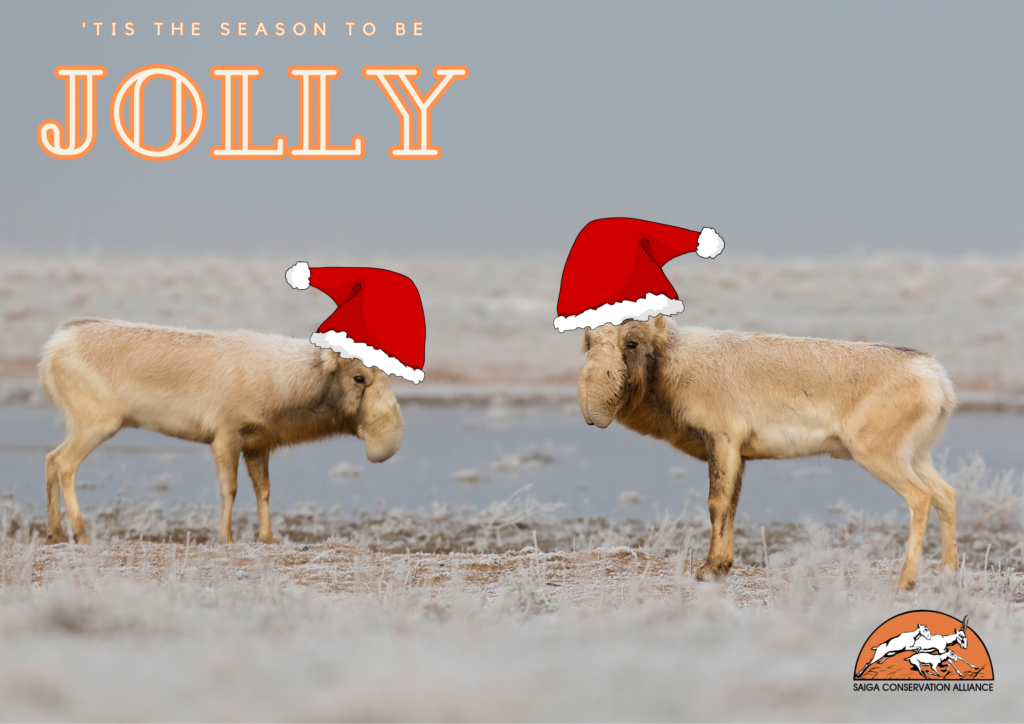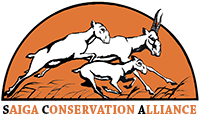As 2024 draws to a close, we, like so many others take time to reflect on the past 12 months and look to the future. This past trip around the sun have been a very significant one for the alliance and all our partners, friends and family. As the title of this blog suggests; the year has been full Progress, Collaboration, and Challenges.
All that has been achieved this past year is simply not possible without your support, generosity and dedication.
Our global alliance thank each and every individual who has partnered with us this year and look forward to the next 12 months with enthusiasm and excitement of what we’ll achieve in 2025.
Be jolly this Christmas, because you have a lot to be jolly for!

2024 In Review
The members of our alliance entered 2024 with a burst of enthusiasm and hope. News that the global Saiga population had risen to 2.83 million and that their IUCN Red List status had shifted to Near Threatened was a milestone worth celebrating. This remarkable success, largely driven by conservation efforts in Kazakhstan, gave us renewed focus. However, the Saiga’s IUCN Green Status as “Largely Depleted,” with a species recovery score of just 38%, reminded us that more work lies ahead—particularly in Mongolia, Russia, and Uzbekistan, where populations remain fragile.
In early 2024, SCA’s partners and steering committee presented a united front against Kazakhstan’s proposed large-scale culling of Saigas in the Ural region. SCA members played a critical role in drawing up Kazakhstan’s national strategy for Saiga conservation and management, and these population control measures directly contradicted its aims. Our alliance reiterated the importance of ethical and evidence-based conservation approaches and highlighted the need for improved systems to manage, catalogue, and store Saiga horn stockpiles.
Youth engagement remains central to our mission. Participation in events like Saiga Day, the Day of Migratory Species, and Steppe Wildlife Clubs has grown across Central Asia. In Uzbekistan, celebrations expanded beyond traditional Saiga ranges to reach new territories, including Tashkent, the capital city.
A decade after the first Saiga Day, the event received national recognition when it was institutionalized by Presidential Decree. Further reinforcing this progress, 2024 was officially declared the Year of the Saiga in Uzbekistan. The government passed a sweeping environmental protection bill, targeting 13 key areas, including wildlife ranger support, environmental education, and protected area management. Among these achievements, SCA steering committee members helped develop zoning plans and objectives for Orolqum (Aral Kum) National Park, designated in 2022.
In late summer, SCA’s local team from Uzbekistan visited the Barsakelmes Biosphere Reserve in Kazakhstan, which marked its 85th anniversary this year. The trip fostered invaluable transboundary cooperation, encouraging:
- Creation of Transboundary Protected Areas: Initiatives aim to preserve ecosystems across the Aral Sea and Ustyurt Plateau.
- Saiga Monitoring Data Exchange: Research on infrastructure projects like the Shalkar-Beineu railway will help mitigate their impact on the Ustyurt Saiga population.
- Potential Saiga Reintroduction: Discussions explored reintroducing Saigas to previously inhabited regions, with future plans to develop actionable proposals.
Participants learned from the Barsakelmes Reserve’s biodiversity conservation strategies across its three clusters: Barsakelmes Island, Kaska Kulan, and the Delta section. This knowledge exchange enhances ongoing efforts, including the Renaissance Island project in Uzbekistan.
In Mongolia, WWF successfully negotiated redesigned railway fences to facilitate safer passage for migratory species. The impact of poorly planned fences was highlighted in the BBC NHU’s new documentary series, “Asia”, which showcased the struggles faced by Saigas and other migratory animals.
Meanwhile, the fight against Saiga horn trafficking remains urgent. Kazakhstan reported two major seizures in autumn 2024:
- September: Wildlife police captured 320 horns and Saiga meat during a traffic stop.
- October: A CyberPol operation in Almaty uncovered 4,500 horns—a seizure concerning for its scale and the aged condition of many horns.
The incidents emphasize the critical need for robust horn stockpile management systems in Saiga range states to prevent horns from entering illegal markets.
SCA’s transboundary project with Fauna and Flora in Uzbekistan and Kyrgyzstan revealed new trafficking routes and evidence of antique Saiga horn knife hilts appearing in local markets. Although there is no sign of modern horn being used for this purpose, vigilance is needed to prevent resurgence in demand.
The Altyn Dala Conservation Initiative (ADCI) in Kazakhstan received the prestigious Earthshot Prize 2024 in the “Protect and Restore Nature” category. While not an SCA project, the award reflects the power of partnerships, and we celebrate with SCA Steering Committee member Albert Salemgareyev (Whitley Award winner and WCN Scholar Alum) and Vera Voronova (ACBK Executive Director), a past recipient of SCA’s Annual Award.
2024 marked a milestone as the UN CMS CoP14 was held in Samarkand, Uzbekistan—a rare opportunity for the global Saiga conservation community to come together.
Key SCA Activities at CMS CoP14:
SCA Annual General Meeting (AGM) & Strategic Planning Workshop Attended by 25 participants from 10 countries, the workshop set strategic priorities for governance, fundraising, and youth engagement. Participants conducted a SWOT analysis and brainstormed ways to enhance SCA’s impact.
Saiga Horn Stockpile Workshop: Addressed challenges of legal horn trade in countries like Malaysia and Vietnam. Proposed improved marking, cataloguing, and storage systems for horns to prevent illegal laundering, particularly following natural mortality events like Kazakhstan’s 2015 Pasteurella outbreak.
Official Side Event: “Recognition and Development of the Success of Transboundary Cooperation on the Restoration of the Saiga Antelope in Central Asia”. Hosted with partners, including the Government of Kazakhstan and Altyn Dala, the event celebrated international cooperation in Saiga recovery.
Saiga Networking Event: A dynamic gathering for Saiga conservationists, featuring themed conversation stations to foster collaboration. Attendees included representatives from Global Ungulate Atlas, WCS Mongolia, ACBK, WWF, TRAFFIC, NABU, and many others.
2024 has been a year of both progress and challenges for Saiga conservation. From celebrating population milestones to addressing pressing threats like infrastructure barriers and horn trafficking, SCA’s efforts have been driven by collaboration, innovation, and advocacy. As we look ahead, our focus remains on ensuring a sustainable future for Saiga antelope populations across Central Asia and beyond.
